Contrasting Trends of Forest Coverage between the Inland and Coastal Urban Groups of China over the Past Decades
Abstract
1. Introduction
2. Materials and Methods
2.1. The Study Area
2.2. ESA CCI Land Cover Data
2.3. Land Use Transfer Matrix
2.4. Landscape Pattern Index
- the landcover class
- the proportion of landscape patch types.
- the area of the patch
- the total area of landscape.
- the boundary length of patches
- the number of similar adjacent patches for the corresponding landscape type.
2.5. Statistical Analysis Method
- (1)
- According to the frequency of forest occurrence in the study area during 1992–2015, the non-forest area, the area where the forest appeared but changed, and the area was always forest for the 24 years were obtained.
- (2)
- In order to assess the trend of forest cover change in the four different urban agglomerations from 1992 to 2015, the entire area was investigated with a 17 × 17 sliding window, and the 24-year trend of forest coverage in the window was analyzed by least squares method. Hence, a spatially continuous distribution of trends of forest changes over the study area was obtained.
- (3)
- Using the 17 × 17 sliding window over the whole area, the transfer matrix for each contiguous two years was calculated, and the land cover types were converted to PFTs. Similarly, the SHDI was calculated for each window each year. Finally, the calculated forest transfer amount and SHDI were assigned to the central pixel of the window, then the transfer amount between forest and other vegetation types and the spatial distribution of landscape diversity were obtained for further analysis.
3. Results
3.1. Temporal and Spatial Variations in the Forests
3.2. Forest Transferations
3.3. Landscape Patterns of Forest
4. Discussion
4.1. The Effect of Mixed Pixels
4.2. Forest Resources in Different Regions
4.3. Regional Landscapes
5. Conclusions
Author Contributions
Funding
Conflicts of Interest
References
- Huslshoff, R.M. Landscape indices describing a Dutch landscape. Landsc. Ecol. 1995, 10, 101–111. [Google Scholar] [CrossRef]
- Huang, L.; Yan, L.J.; Wu, J.G. Assessing urban sustainability of Chinese megacities: 35 years after the economic reform and open-door policy. Landsc. Urban Plan. 2015, 145, 57–70. [Google Scholar] [CrossRef]
- Vitousek, P.M. Beyond global warming: Ecology and Global Change. Ecology 1994, 75, 1861–1876. [Google Scholar] [CrossRef]
- Gholoubi, A.; Emami, H.; Alizadeh, A. Soil quality change 50 years after forestland conversion to tea farming. Soil Res. 2018, 56, 509–517. [Google Scholar] [CrossRef]
- Turner, M.G.; Romme, W.H.; Gardner, R.H.; Robert, V.O.; Timothy, K.K. A revised concept of landscape equilibrium: Disturbance and stability on scaled landscapes. Landsc. Ecol. 1993, 8, 213–227. [Google Scholar] [CrossRef]
- Nuissl, H.; Haase, D.; Lanzendorf, M.; Wittmer, H. Environmental impact assessment of urban land use transitions: A context-sensitive approach. Land Use Policy 2009, 26, 414–424. [Google Scholar] [CrossRef]
- Gustafson, E.J. Quantifying landscape spatial pattern: What is the state of the art? Ecosystems 1998, 1, 134–156. [Google Scholar] [CrossRef]
- Krummel, J.R.; Gardner, R.H.; Sugihara, G. Landscape patterns in a disturbed environment. Oikos 1987, 48, 321–324. [Google Scholar] [CrossRef]
- Turner, M.G.; Ruscher, C.L. Changes in landscape patterns in Georgia, USA. Landsc. Ecol. 1988, 1, 241–251. [Google Scholar] [CrossRef]
- Turner, M.G. Landscape changes in nine rural counties in Georgia. Photogramm. Eng. Remote Sens. 1990, 56, 379–386. [Google Scholar]
- Chen, W.B.; Xiao, D.N.; Li, X.Z. Classification, application, and creation of landscape indices. Chin. J. Appl. Ecol. 2002, 13, 121–125. [Google Scholar]
- Watt, A.S. Pattern and process in the plant community. J. Ecol. 1947, 35, 1–22. [Google Scholar] [CrossRef]
- Chi, W.F.; Shi, W.J.; Kuang, W.H. Spatio-temporal characteristics of intra-urban land cover in the cities of China and USA from 1978 to 2010. J. Geogr. Sci. 2015, 25, 3–18. [Google Scholar] [CrossRef]
- Fu, B.J.; Lü, Y.H.; Chen, L.D.; Su, C.H.; Yao, X.L.; Liu, Y. The latest progress of landscape ecology in the world. Acta Ecol. Sin. 2008, 28, 0798–0804. [Google Scholar]
- Morris, S.J.; Boerner, R.E.J. Landscape patterns of nitrogen mineralization and nitrification in southern Ohio hardwood forests. Landsc. Ecol. 1998, 13, 215–224. [Google Scholar] [CrossRef]
- Schwartz, N.B.; Budsock, A.M.; Uriarte, M. Fragmentation, forest structure, and topography modulate impacts of drought in a tropical forest landscape. Ecology 2019, 100, e02677. [Google Scholar] [CrossRef]
- Guo, C.Y.; Gao, S.; Zhou, B.Y.; Gao, J.H. Effects of land use change on ecosystem service value in Funiu Mountain based upon a grid square. Acta Ecol. Sin. 2019, 39, 3482–3493. [Google Scholar]
- Feng, S.; Sun, R.H.; Chen, L.D. Spatio-temporal variability of habitat quality based on land use pattern change in Beijing. Acta Ecol. Sin. 2018, 38, 4167–4179. [Google Scholar]
- Gage, E.A.; Cooper, D.J. Relationships between landscape pattern metrics, vertical structure and surface urban Heat Island formation in a Colorado suburb. Urban Ecosyst. 2017, 20, 1229–1238. [Google Scholar] [CrossRef]
- Zhao, Y.B.; Wang, S.J.; Zhou, C.S. Understanding the relation between urbanization and the eco-environment in China’s Yangtze River Delta using an improved EKC model and coupling analysis. Sci. Total Environ. 2016, 571, 862–875. [Google Scholar] [CrossRef]
- Del Castillo, E.M.; Garcia-Martin, A.; Aladren, L.A.L.; de Luis, M. Evaluation of forest cover change using remote sensing techniques and landscape metrics in Moncayo Natural Park (Spain). Appl. Geogr. 2015, 62, 247–255. [Google Scholar] [CrossRef]
- Recanatesi, F. Variations in land-use/land-cover changes (LULCCs) in a peri-urban Mediterranean nature reserve: The estate of Castelporziano (Central Italy). Rend. Fis. Acc. Lincei 2015, 26, 517–526. [Google Scholar] [CrossRef]
- Yuan, Y.; Shi, P.J.; Liu, Y.H.; Xie, F. A study on the pattern of land cover during rapid urbanization: Shenzhen City as a case study. Acta Ecol. Sin. 2003, 23, 1832–1840. [Google Scholar]
- Redman, C.L. Human dimensions of ecosystem studies. Ecosystems 1999, 2, 296–298. [Google Scholar] [CrossRef]
- Alberti, M. The effects of urban patterns on ecosystem function. Int. Reg. Sci. Rev. 2005, 28, 168–192. [Google Scholar] [CrossRef]
- Antrop, M. Landscape change and the urbanization process in Europe. Landsc. Urban Plan. 2004, 67, 9–26. [Google Scholar] [CrossRef]
- Schroter, D.; Cramer, W.; Leemans, R.; Prentice, I.C. Ecosystem Service Supply and Vulnerability to Global Change in Europe. Science 2005, 310, 1333–1337. [Google Scholar] [CrossRef]
- Briber, B.M.; Hutyra, L.R.; Reinmann, A.B.; Raciti, S.M.; Dearborn, V.K.; Holden, C.E. Tree Productivity Enhanced with Conversion from Forest to Urban Land Covers. PLoS ONE 2015, 10, e0136237. [Google Scholar] [CrossRef]
- Wang, J.; Zhou, W.Q.; Xu, K.P.; Yan, J.L. Spatiotemporal pattern of vegetation cover and its relationship with urbanization in Beijing-Tianjin-Hebei megaregion from 2000 to 2010. Acta Ecol. Sin. 2017, 37, 7019–7029. [Google Scholar]
- Ma, T. Spatiotemporal characteristics of urbanization in china from the perspective of remotely sensed big data of nighttime light. J. Geo-Inf. Sci. 2019, 21, 59–67. [Google Scholar]
- Zhou, L.M.; Dickinson, R.E.; Tian, Y.H.; Fang, J.Y.; Li, Q.X.; Kaufmann, R.K.; Tucker, C.J.; Myneni, R.B. Evidence for a significant urbanization effect on climate in China. Proc. Natl. Acad. Sci. USA 2004, 101, 9540–9544. [Google Scholar] [CrossRef]
- Bai, X.M.; McAllister, R.R.J.; Beaty, R.M.; Taylor, B. Urban policy and governance in a global environment: Complex systems, scale mismatches and public participation. Curr. Opin. Environ. Sustain. 2010, 2, 129–135. [Google Scholar] [CrossRef]
- Grimm, N.B.; Faeth, S.H.; Golubiewski, N.E.; Redman, C.L.; Wu, J.G.; Bai, X.; Briggs, J.M. Global change and the ecology of cities. Science 2008, 319, 756–760. [Google Scholar] [CrossRef]
- Jin, K.; Wang, F.; Li, P. Responses of Vegetation Cover to Environmental Change in Large Cities of China. Sustainability 2018, 10, 270. [Google Scholar] [CrossRef]
- Land Cover CCI Climate Research Data Package. Available online: http://maps.elie.ucl.ac.be/CCI/viewer/download.php (accessed on 10 November 2017).
- Li, W.; MacBean, N.; Ciais, P.; Defourny, P.; Lamarche, C.; Bontemps, S.; Houghton, R.A.; Peng, S.S. Gross and net land cover changes in the main plant functional types derived from the annual ESA CCI land cover maps (1992–2015). Earth Syst. Sci. Data 2018, 10, 219–234. [Google Scholar] [CrossRef]
- Luck, M.; Wu, J. A gradient analysis of urban landscape pattern: A case study from the Phoenix metropolitan region, Arizona, USA. Landsc. Ecol. 2002, 17, 327–329. [Google Scholar] [CrossRef]
- Hess, G.R.; Bay, J.M. Generating confidence intervals for composition-based landscape indexes. Landsc. Ecol. 1997, 12, 309–320. [Google Scholar] [CrossRef]
- Land Cover CCI Product User Guide Version 2.0. Available online: http://maps.elie.ucl.ac.be/CCI/viewer/download/ESACCI-LC-Ph2-PUGv2_2.0.pdf (accessed on 10 November 2017).
- Poulter, B.; MacBean, N.; Hartley, A.; Khlystova, I.; Arino, O.; Betts, R.; Bontemps, S.; Boettcher, M.; Brockmann, C.; Defourny, P.; et al. Plant functional type classification for earth system models: Results from the European Space Agency’s Land Cover Climate Change Initiative. Geosci. Model Dev. 2015, 8, 2315–2328. [Google Scholar] [CrossRef]
- National Bureau of Statistics of China. Available online: http://data.stats.gov.cn/easyquery.htm?cn=C01 (accessed on 21 November 2017).
- Bai, X.M.; Shi, P.J.; Liu, Y.S. Realizing China’s urban dream. Nature 2014, 509, 158–160. [Google Scholar] [CrossRef]
- Chen, M.X.; Liu, W.D.; Tao, X.L. Evolution and assessment on China’s urbanization 1960-2010: Under-urbanization or over-urbanization? Habitat Int. 2013, 38, 25–33. [Google Scholar] [CrossRef]
- Cui, Y.; Liu, J.; Xu, X.; Dong, J.; Li, N.; Fu, Y.; Lu, S.; Xia, H.; Si, B.; Xiao, X. Accelerating Cities in an Unsustainable Landscape: Urban Expansion and Cropland Occupation in China, 1990–2030. Sustainability 2019, 11, 2283. [Google Scholar] [CrossRef]
- Morton, D.C.; DeFries, R.S.; Shimabukuro, Y.E.; Anderson, L.O.; Arai, E.; Espirito-Santo, F.D.B.; Freitas, R.; Morisette, J. Cropland expansion changes deforestation dynamics in the southern Brazilian Amazon. Proc. Natl. Acad. Sci. USA 2006, 103, 14637–14641. [Google Scholar] [CrossRef]
- Ye, Y.; Fang, X.Q.; Ren, Y.Y.; Zhang, X.Z.; Chen, L. Cropland cover change in Northeast China during the past 300 years. Sci. China Ser. D Earth Sci. 2009, 52, 1172–1182. [Google Scholar] [CrossRef]
- Deng, X.Z.; Huang, J.K.; Rozelle, S.; Uchida, E. Cultivated land conversion and potential agricultural productivity in China. Land Use Policy 2006, 23, 372–384. [Google Scholar] [CrossRef]
- Xiao, D.N.; Zhao, Y.; Sun, Z.W.; Zhang, G.S. Study on the variation of landscape pattern in the western suburbs of shenyang. Appl. Ecol. 1990, 1, 75–84. [Google Scholar]
- Zhang, Y.X.; Guo, J.P. The Dynamics of Patch Density and Edge Density in Forested Landscape of Shanxi, China A Case Study in Guandis-han Mountain Forest District. Chin. J. Ecol. 2001, 20, 18–21. [Google Scholar]
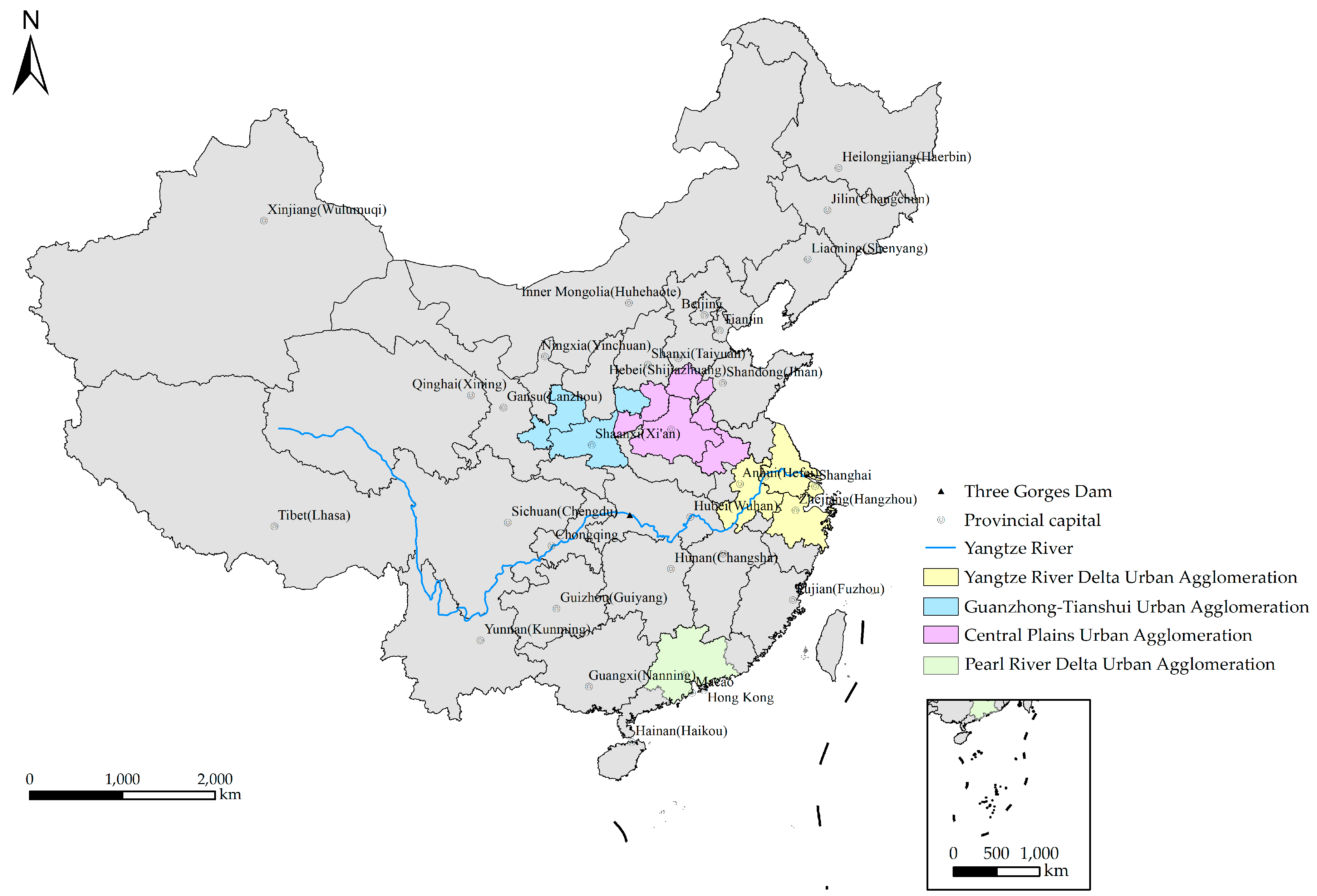
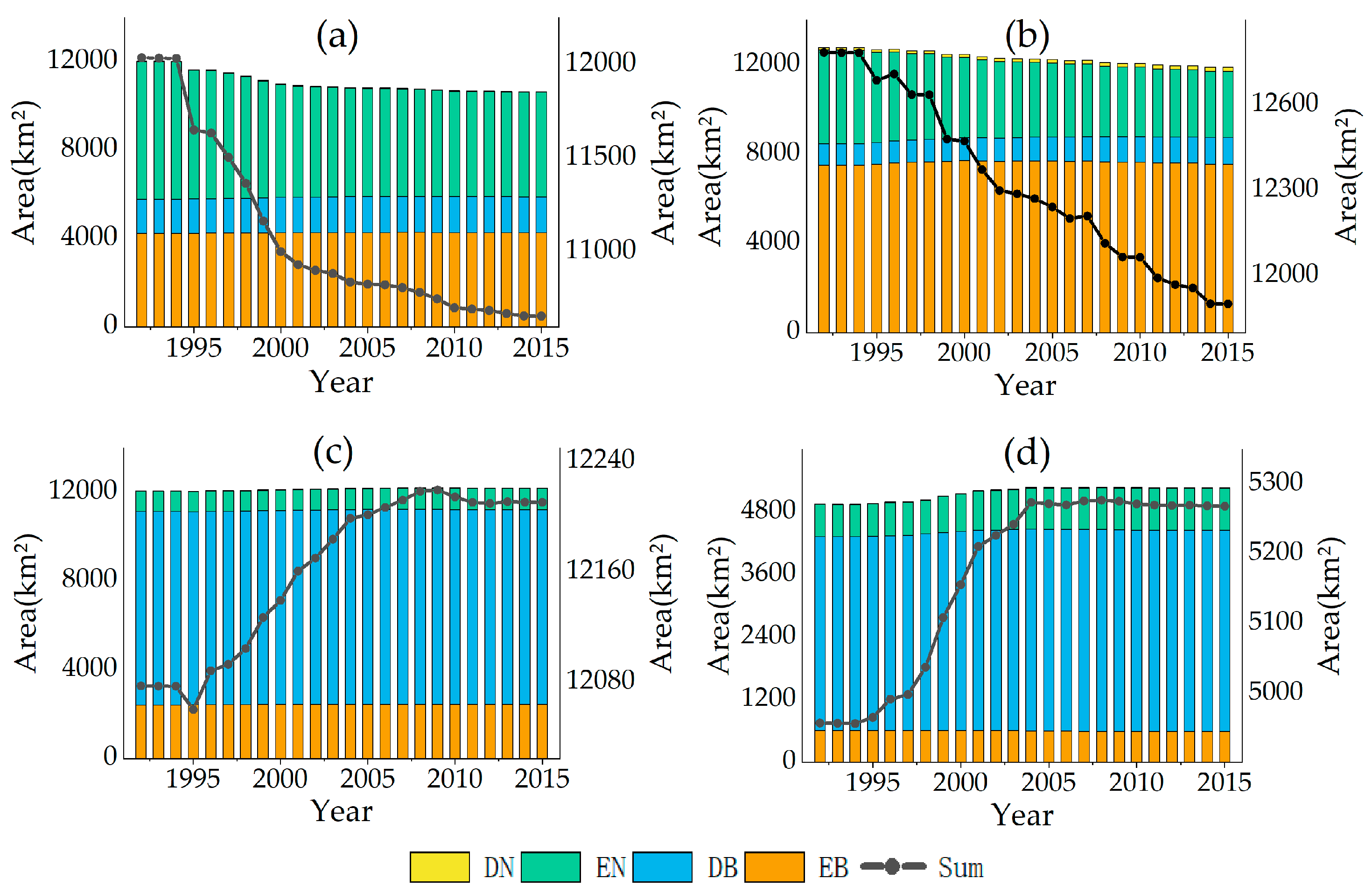
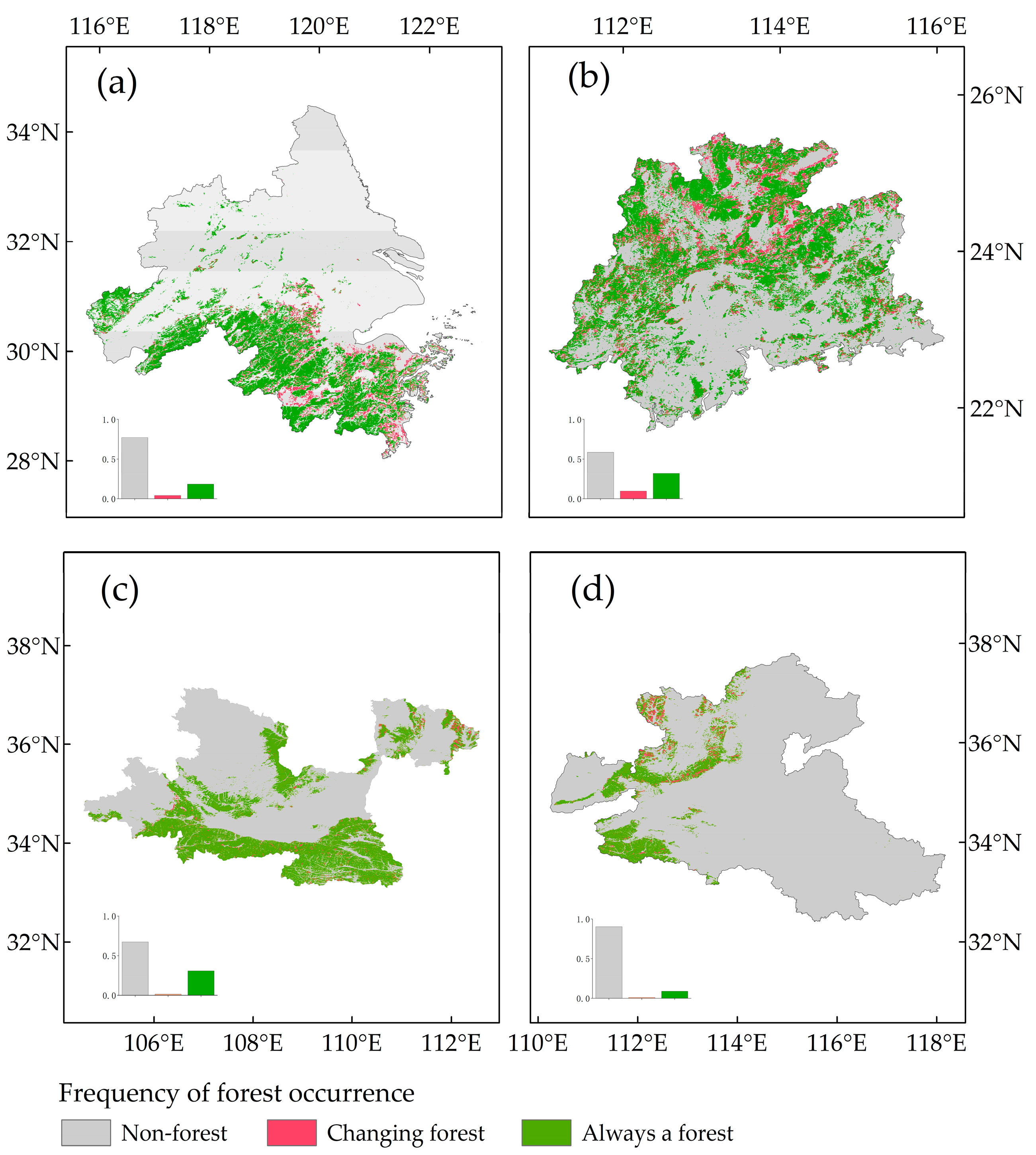
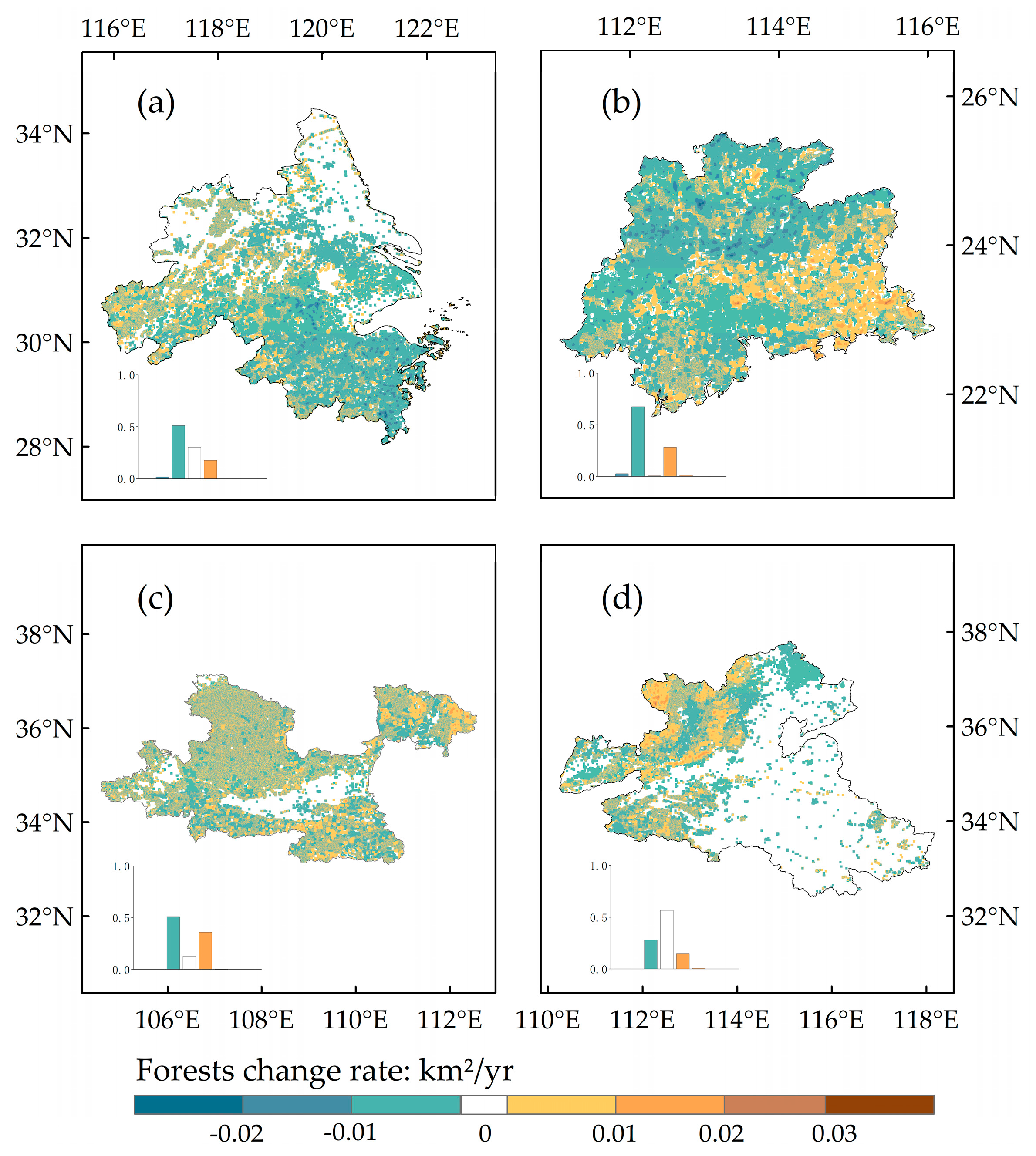
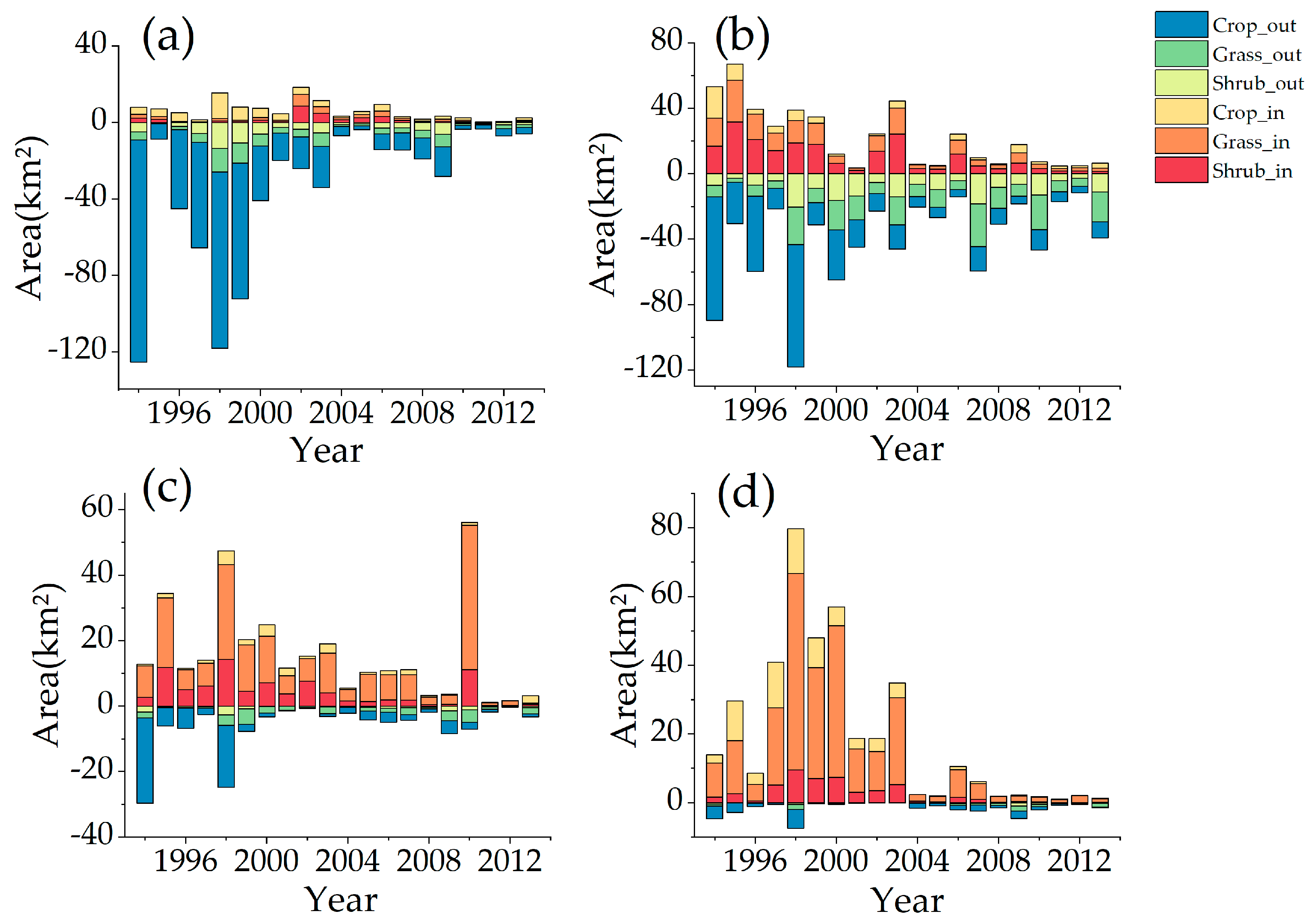
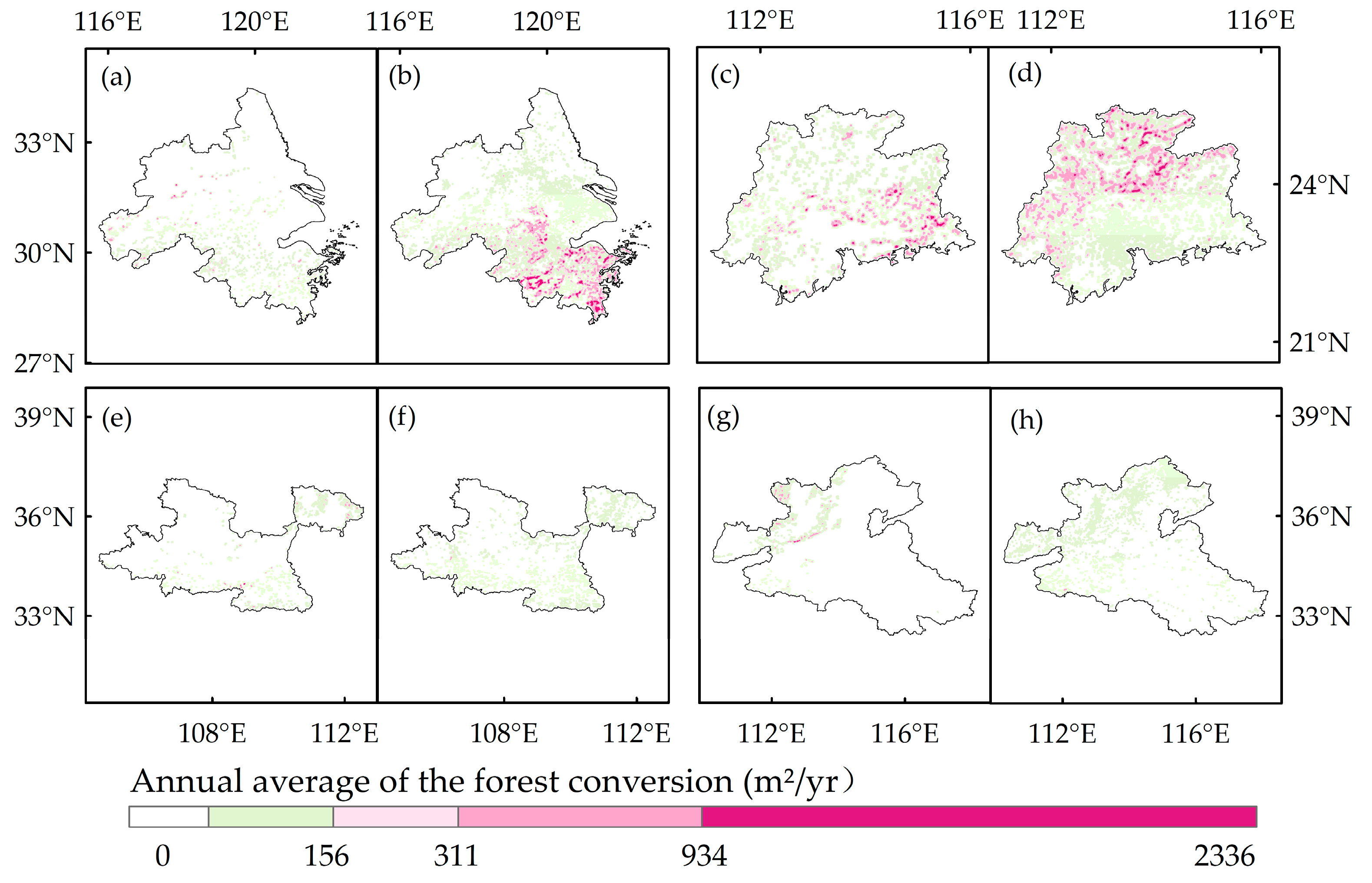
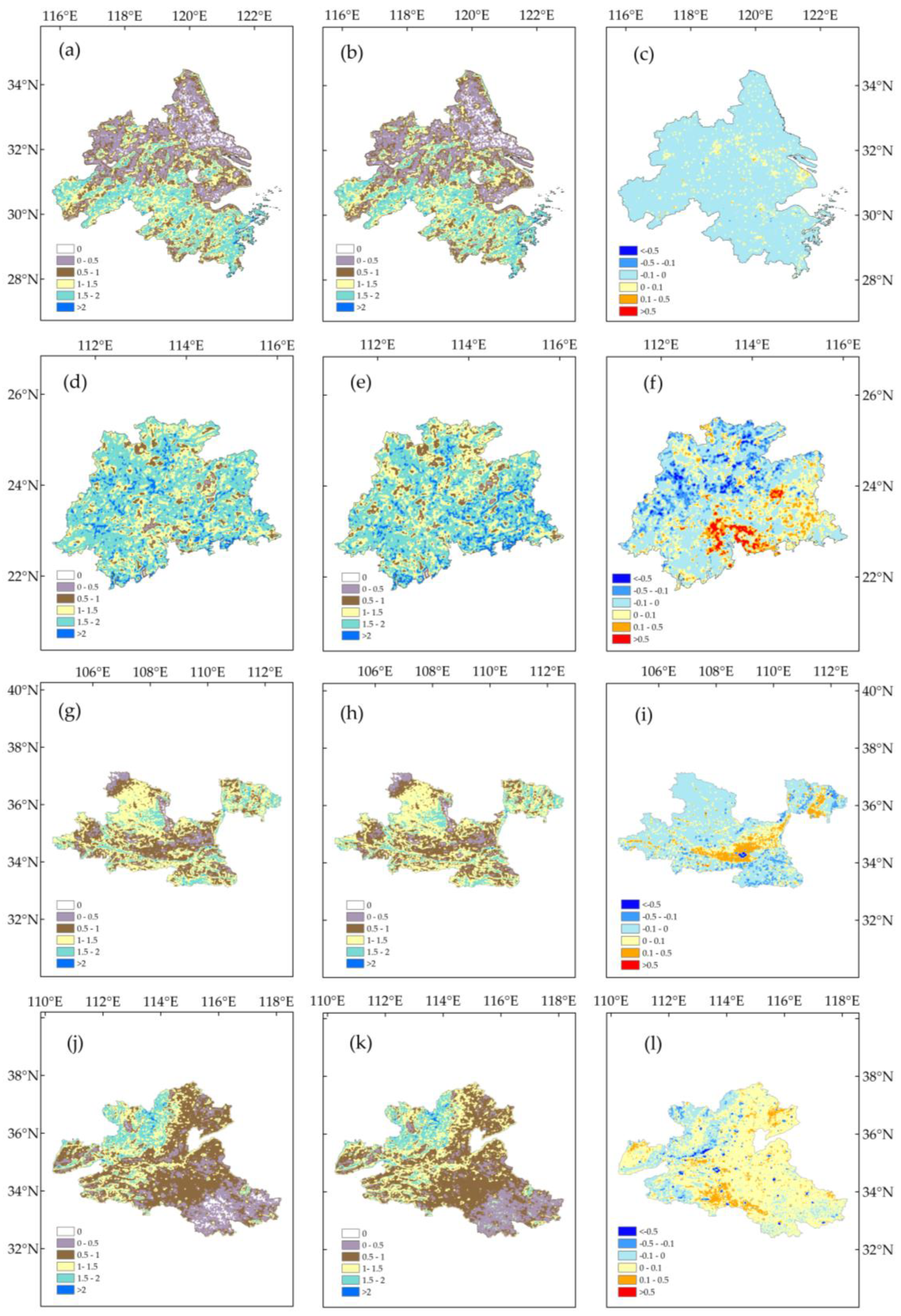
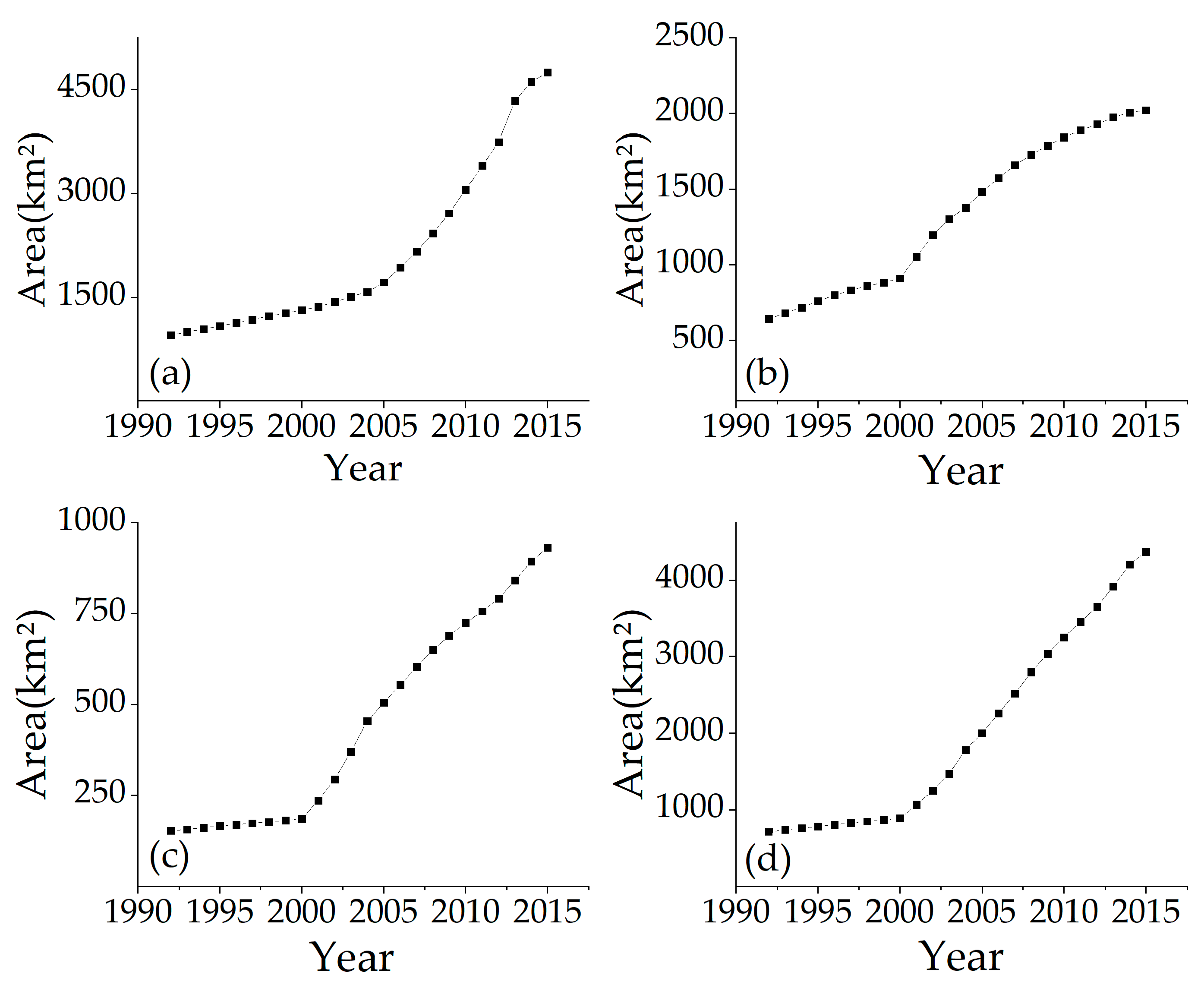
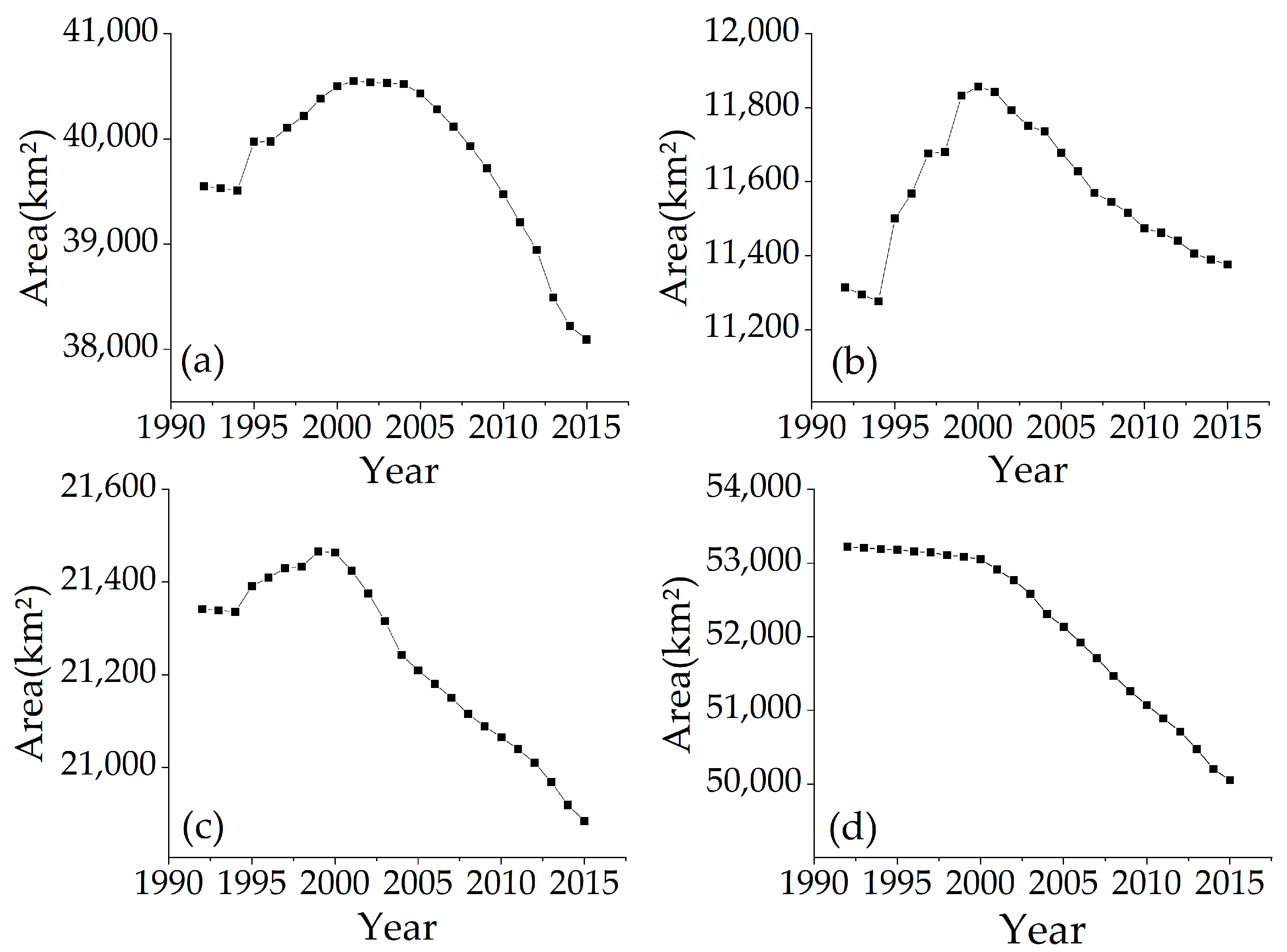
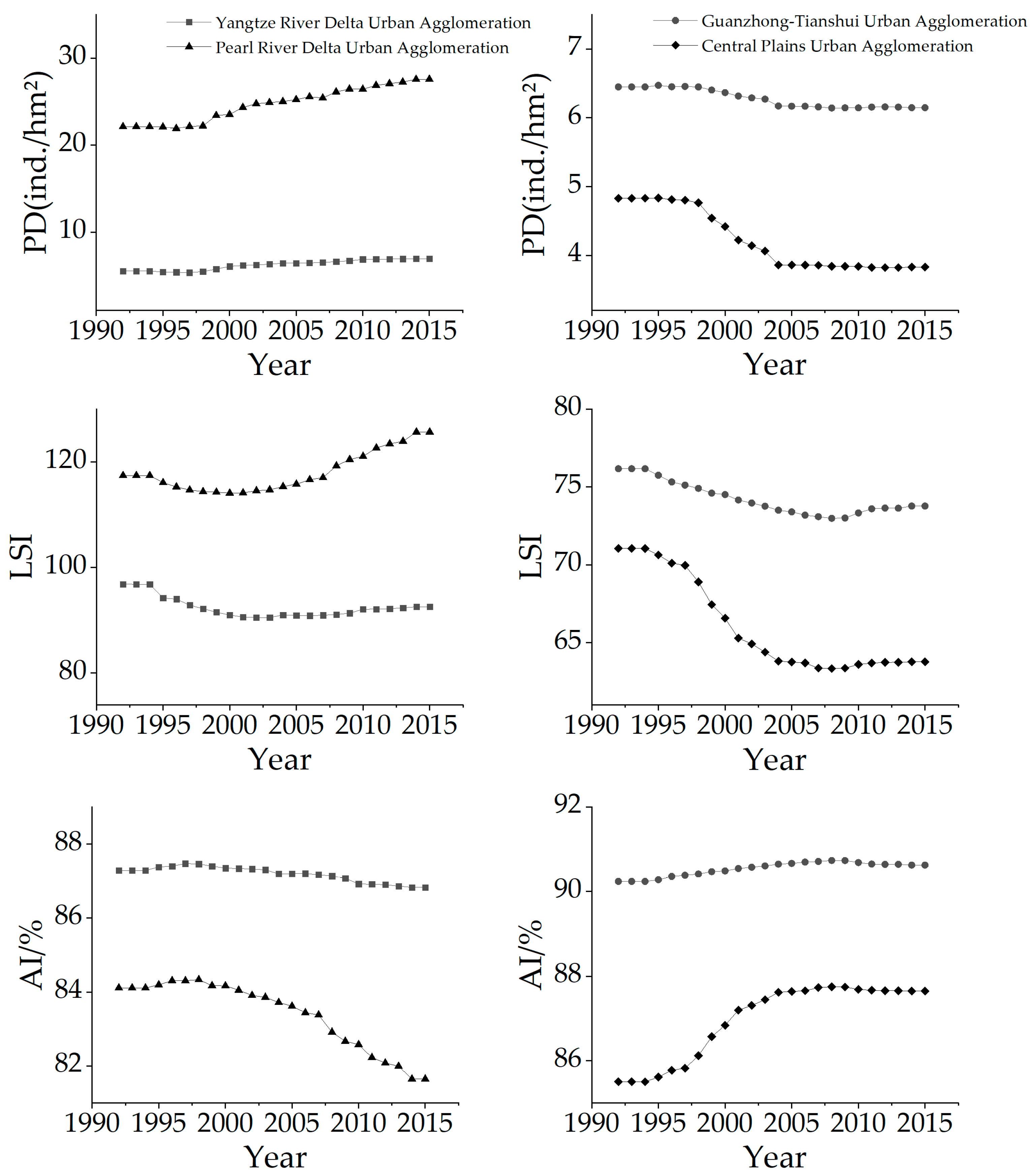
| Class 1 | Class 2 | Class 1 | Class 2 |
|---|---|---|---|
| Tree | Evergreen Broadleaf | Grass | Grass |
| Deciduous Broadleaf | |||
| Evergreen Needleleaf | Crop | Natural Crop | |
| Deciduous Needleleaf | |||
| Shrub | Evergreen Broadleaf | Non-Vegetated | Bare Soil |
| Deciduous Broadleaf | Water | ||
| Evergreen Needleleaf | Snow/Ice | ||
| Deciduous Needleleaf | Urban |
| Index | Formula | Description |
|---|---|---|
| SHDI | measurement of landscape diversity | |
| PD | reflections of patch fragmentation | |
| LSI | reflections of patch shape complexity | |
| AI | 0 | reflections of patch aggregation degree |
© 2019 by the authors. Licensee MDPI, Basel, Switzerland. This article is an open access article distributed under the terms and conditions of the Creative Commons Attribution (CC BY) license (http://creativecommons.org/licenses/by/4.0/).
Share and Cite
Zhu, Q.; Jin, J.; Wang, P.; Ji, Y.; Xiao, Y.; Guo, F.; Deng, C.; Qu, L. Contrasting Trends of Forest Coverage between the Inland and Coastal Urban Groups of China over the Past Decades. Sustainability 2019, 11, 4451. https://doi.org/10.3390/su11164451
Zhu Q, Jin J, Wang P, Ji Y, Xiao Y, Guo F, Deng C, Qu L. Contrasting Trends of Forest Coverage between the Inland and Coastal Urban Groups of China over the Past Decades. Sustainability. 2019; 11(16):4451. https://doi.org/10.3390/su11164451
Chicago/Turabian StyleZhu, Qingsong, Jiaxin Jin, Pengxiang Wang, Yingying Ji, Yuanyuan Xiao, Fengsheng Guo, Changsheng Deng, and Lisha Qu. 2019. "Contrasting Trends of Forest Coverage between the Inland and Coastal Urban Groups of China over the Past Decades" Sustainability 11, no. 16: 4451. https://doi.org/10.3390/su11164451
APA StyleZhu, Q., Jin, J., Wang, P., Ji, Y., Xiao, Y., Guo, F., Deng, C., & Qu, L. (2019). Contrasting Trends of Forest Coverage between the Inland and Coastal Urban Groups of China over the Past Decades. Sustainability, 11(16), 4451. https://doi.org/10.3390/su11164451





